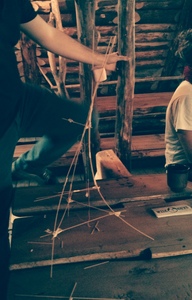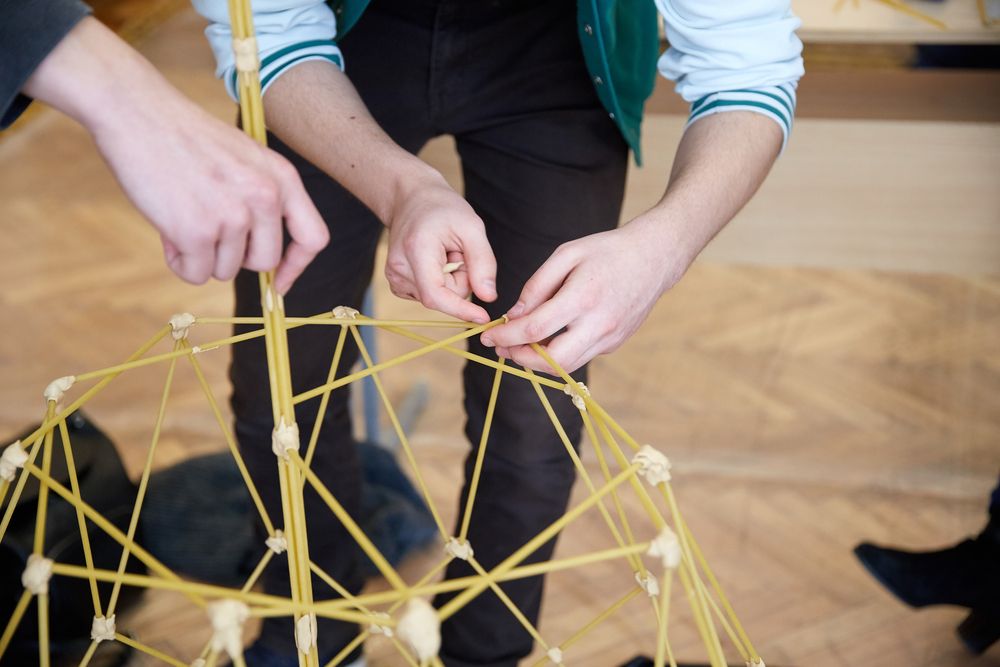Marshmallow challenge with debriefing

In eighteen minutes, teams must build the tallest free-standing structure out of 20 sticks of spaghetti, one yard of tape, one yard of string, and one marshmallow. The marshmallow needs to be on top.
The Marshmallow Challenge was developed by Tom Wujec, who has done the activity with hundreds of groups around the world. Visit the Marshmallow Challenge website for more information. This version has an extra debriefing question added with sample questions focusing on roles within the team.
Goal
Create a teamwork experience that can be debriefed along various angles, such as roles in a team, or what it takes to innovate
Materials
Instructions
Before starting the challenge, make sure that there is a table set up with materials for each team.
Create teams of four participants, explain the task below and run the challenge.
The task is simple: in eighteen minutes, teams must build the tallest free-standing structure out of 20 sticks of spaghetti, one yard of tape, one yard of string, and one marshmallow. The marshmallow needs to be on top.
Emphasise the following details of the instructions while briefing the marhsmallow challenge:
- Build the Tallest Freestanding Structure: The winning team is the one that has the tallest structure measured from the table top surface to the top of the marshmallow. That means the structure cannot be suspended from a higher structure, like a chair, ceiling or chandelier.
- The Entire Marshmallow Must be on Top: The entire marshmallow needs to be on the top of the structure. Cutting or eating part of the marshmallow disqualifies the team.
- Use as Much or as Little of the Kit: The team can use as many or as few of the 20 spaghetti sticks, as much or as little of the string or tape. The team cannot use the paper bag as part of their structure.
- Break up the Spaghetti, String or Tape: Teams are free to break the spaghetti, cut up the tape and string to create new structures.
- The Challenge Lasts 18 minutes: Teams cannot hold on to the structure when the time runs out. Those touching or supporting the structure at the end of the exercise will be disqualified.
- Ensure Everyone Understands the Rules: Don’t worry about repeating the rules too many times. Repeat them at least three times. Ask if anyone has any questions before starting.
After the clock runs out, ask everyone in the room to sit down so everyone can see the structures. Measure the structures and announce the winning team.

Debriefing
After the Marshmallow Challenge is finished, move on with the debriefing discussion (you may use the leading questions from the attached ppt):
Show debriefing questions and instruct to:
1) Reflect alone (5 mins)
2) Sharing within team (10 mins)
3) Triad discussions with extra questions about roles (3*3 mins)
Debriefing questions:
- For personal reflection:
- What was the strategy of the team?
- What was my role in the team?
- What worked well in my team?
- What would I improve next time in my team’s work?
- For sharing within the team:
- What worked well in my team?
- What would I improve next time in my team’s work?
- For triad discussion:
- What are the advantageous aspects of your role? (that you usually take)
- What are the disadvantageous aspects of your role? (that you usually take)
- What learning would you take away from this exercise?
The lessons learned from the Marshmallow Challenge are as powerful as the fun and team building aspects of the exercise. Try to let groups come up with their own takeaways, though if they're having trouble, I find encouraging them to think of the marshmallow, spaghetti and tape as a metaphor can be a powerful way to get things moving.
Tips for running the Marshmallow Challenge
- Resistance to the Marshmallow Challenge is possible, though infrequent. When briefing the exercise, it's worth letting the group know that the activity has been used thousands of times by teams around the world and that the value of the exercise is in the lessons it teaches and the reflections it helps surface.
- Playing music during the Marshmallow Challenge is recommended! I recommend playing something upbeat and relevant to your group or even asking the group for suggestions.
- The briefing for the Marshmallow Challenge is everything. Ensure you provide clarity on the rules of the game and invite clarifying questions from the group. This can ensure everyone's thoughts are on the challenge at hand.
- Creating a sense of energy and friendly competition is a great way to get buy-in when running the Marshmallow Challenge. Try occupying the role of commentator/MC and hype up teams who are being creative. You may also include a small prize for the winning team, though also allude to the real prize being some of the lessons you might learn along the way!
Attachments
- marshmallow challenge team building.jpg
- Marshmallow-challenge-with-debriefing.jpeg
- Debriefing_questions_-_Marshmallow_challenge.pptx
Background
Source: Tow Wujec - Marshmallow challenge
See the illustration of the exercise from the TED talk of Tom Wujec: Build a tower, build a team
Next steps
- Explore more effective team building activities for your next team event or culture-building session.
- Running a session with over 20+ people? See more large group games that scale well for large gatherings.
- Discover how to create a workshop agenda that incorporates the Marshmallow challenge into a structured learning flow.
Author
Robert is the co-founder of SessionLab, an online platform that helps people design and facilitate better meetings. Besides developing SessionLab, time to time he also facilitates various workshops and training sessions and particularly enjoys process design for large group workshops. He was trained as a facilitator and internal soft skills trainer by BEST, a European youth NGO, where he conducted soft skill training sessions, facilitated strategic meetings, and designed and delivered train-the-trainer programmes within the organisation. During his years as a business process consultant, he got familiar with facilitating operative and strategic business meetings and large group workshops.
More about author